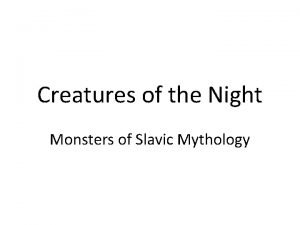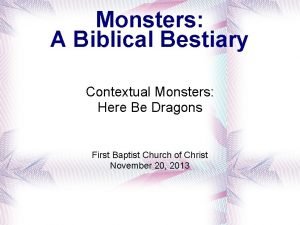Creatures of the Night Monsters of Slavic Mythology




















- Slides: 20

Creatures of the Night Monsters of Slavic Mythology

Vampires • Vampires are one of the few mythological creatures that have existed in many major civilizations that we have documentation of. • Comes from the Slavic word vampir. • In the South Slavs, the vampire and werewolf myths have become intertwined. • However, unlike werewolves, vampires are essentially manifestations of the ghostly unclean dead.

Who Become Vampires? • In Slavic mythology, it was believed that only certain categories of people would become vampires. • This included: werewolves, sorcerers, witches, sinners, and heretics. • In Bulgaria and Romania, it was believed that murderers, robbers, prostitutes, and other socially undesirable people would also become vampires after death.

Modern Ways • In our Vampire mythology today, people become vampires through various means. • The most famous being bitten by a Vampire. • Another familiar way is drinking the blood of a vampire, or simply drinking blood. • However, in recent pop culture, it is believed that vampires could reproduce and create vampire children.

Vampire Appearance • According to Slavic mythology, people conceived or born on a holy day, the stillborn, and those born with bony growths at the bottom of their backbone (tail) or teeth were marked out as vampires. • Slavic tradition also maintains that vampires could be pale in appearance (from their lack of blood) or dark in their appearance (from their rotting skin).

Modern Ideas • Today, vampires are thought to have pale skin, white fangs and cast a dark shadow. • Other than that, they are mostly characterized as looking like anyone else.

Vampire Beliefs • Slavic tradition maintains that vampires remain in the grave undecayed and often bloated (signifying they are full of blood). • There were also said to be signs of movement in the grave, sometimes turning face down in the coffin.

Vampire Beliefs • The tradition continues that at midnight vampires would visit houses to suck the blood of or have sex with the sleeping, often their own relations, who would then waste away and die. • The idea of the vampire rising from the grave to stalk the living has died out in the past 200 years.

Vampire Protection • Methods of combating vampires are numerous and depend on the source of the myth. • Some methods are designed to allow the vampire to rest in peace, such as placing a small cross in the grave, or flax or millet grains to keep them busy counting.

• The most famous and well know method for combating vampires is staking. • Taking a sharpened hawthorn or aspen stake and driving it through the chest or head of the vampire. This was thought to keep them in the grave. • Alternatively, the body could them be decapitated, dismembered, or have the heels and ankles maimed to inhibit movement (depending on the culture)

Vampire Hunting • Through the years, and through different interpretations, vampire weaknesses have grown and include several strange things. • Most common are: Sunlight, Garlic, Wolfsbane, Fire, Silver, Running Water, and Holy Objects. • It was also widely held that a vampire could not enter your premises without first being invited.

Another Vampire Weakness • Although sources vary, it is generally believed that the vampire must sleep in either the coffin they were buried in or in the earth/dirt they were buried in.

Famous Vampire Hunters • • Abraham Van Helsing Blade Abraham Lincoln Buffy the Vampire Slayer

Werewolves • The whole Slavic area from ancient times was permeated by beliefs about werewolves (lycanthropy), which in time merged with the idea of the vampire. • This is why some of their weaknesses are so similar.

What is a Werewolf? • A mythical or folkloric human with the ability to shape shift into a wolf or an anthropomorphic wolflike creature. • Although it was believed that these people could turn into several animals, it was the bloodthirsty wolf that they were believed to prefer.

Who were Werewolves? • People believed to be under a curse or affliction (a bite or scratch from another werewolf) were said to be werewolves. • Those that were born with a birthmark, wolfish tufts of hair or with a caul (a membrane that covered a baby’s face…which only occurred in 1 out of every 800, 000 births). • Others physical traits of people who werewolves were: a unibrow, curved fingernails, and a swinging stride.

Cures for Werewolves • The ancient Greeks believed that exhaustion was a possible cure and people believed to be werewolves were subjected to great physical activities. • During the Middle Ages in Europe there were three common methods to cure werewolves: medically (usually involved ingesting wolfsbane), surgically (where the surgeon would try to remove the werewolf from inside you), and exorcism (in which they tried to remove the werewolf from your soul). • Most of these “cures” proved fatal for the victim.

Modern Day “Cures” • In our modern mythology, there aren’t really ways to cure the werewolf, but there are several used to kill one. • The most famous being a silver weapon, a club, walking stick, or a knife. • The most famous however is the silver bullet.

Modern Day Werewolves • Werewolves were believed to be highly tolerate of pain and injury. • In fact it was believed that not even fire or drowning could completely destroy the werewolf…only silver. • However modern medical research has discovered what might have been the real cause of werewolfism.

Hypertrichosis • A medical condition which causes an abnormal amount of hair to grow over the body. • This is usually genetic and can be seen even at birth. • Severe cases have even been dubbed “werewolf syndrome. ”
 Slavic mythology creatures
Slavic mythology creatures Roman mythology creatures
Roman mythology creatures Bulgarian mythological creatures
Bulgarian mythological creatures Thai dragon mythology
Thai dragon mythology Balto slavic languages
Balto slavic languages Slavonic language
Slavonic language Irma potočnik slavič
Irma potočnik slavič Is latvia slavic
Is latvia slavic Language families
Language families Slavic langauge
Slavic langauge Byzantine definition
Byzantine definition Is slavic indo european
Is slavic indo european Radegast god
Radegast god Silent night holy night all is calm all is bright
Silent night holy night all is calm all is bright Weisels
Weisels Econmovies #3 monsters inc. production possibilities
Econmovies #3 monsters inc. production possibilities Where do monsters lurk
Where do monsters lurk Facing monsters
Facing monsters Creatures of the underworld
Creatures of the underworld Monsters inc realistic
Monsters inc realistic Nephilim
Nephilim



































